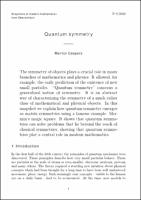| dc.contributor.author | Caspers, Martijn | |
| dc.contributor.editor | Munday, Sara | |
| dc.contributor.editor | Jahns, Sophia | |
| dc.date.accessioned | 2021-02-02T12:54:59Z | |
| dc.date.available | 2021-02-02T12:54:59Z | |
| dc.date.issued | 2020-12-31 | |
| dc.identifier.uri | http://publications.mfo.de/handle/mfo/3831 | |
| dc.description.abstract | The symmetry of objects plays a crucial role in many
branches of mathematics and physics. It allowed, for
example, the early prediction of the existence of new
small particles. “Quantum symmetry” concerns a
generalized notion of symmetry. It is an abstract
way of characterizing the symmetry of a much richer
class of mathematical and physical objects. In this
snapshot we explain how quantum symmetry emerges
as matrix symmetries using a famous example: Mermin’s
magic square. It shows that quantum symmetries
can solve problems that lie beyond the reach of
classical symmetries, showing that quantum symmetries
play a central role in modern mathematics. | en_US |
| dc.language.iso | en | en_US |
| dc.publisher | Mathematisches Forschungsinstitut Oberwolfach | en_US |
| dc.relation.ispartofseries | Snapshots of modern mathematics from Oberwolfach;2020,09 | |
| dc.rights | Attribution-ShareAlike 4.0 International | * |
| dc.rights.uri | http://creativecommons.org/licenses/by-sa/4.0/ | * |
| dc.title | Quantum symmetry | en_US |
| dc.type | Article | en_US |
| dc.identifier.doi | 10.14760/SNAP-2020-009-EN | |
| local.series.id | SNAP-2020-009-EN | en_US |
| local.subject.snapshot | Analysis | en_US |
| dc.identifier.urn | urn:nbn:de:101:1-2021020215170056668177 | |
| dc.identifier.ppn | 1747386847 | |


